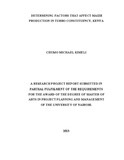| dc.description.abstract | Maize is the most important cereal crop in Kenya. It forms an important part of the food
and feed system, and contributes significantly to income generation for rural households.
It is the main staple food for the people of Kenya, providing more than a third of the
caloric intake. In terms of land usage, maize accounts for about 56% of cultivated land in
Kenya. About 98% of the 3.5 million small-scale farmers in Kenya are engaged in maize
production. The study covered the determining factors that affect maize production in
Turbo Constituency, Kenya. The objectives of the study included: To investigate the
effect of climatic change on maize production in Turbo Constituency, to determine the
effect of market demand for maize production in Turbo Constituency, to determine the
effect of inputs available in maize production in Turbo Constituency, to determine the
effect of quantity of maize produced in Turbo Constituency and to establish other
activities carried out in Turbo Constituency. The research shall be of great benefit to;
farmers, maize traders, future researchers and the donor community in the region. The
total maize farmers’ population according to the Ministry of Agriculture Turbo
Constituency branch was 5210, the target population for the farmers was 140 and a
sample size of 103 was used. Sample size was scientifically computed through Krejcie
and Morgan’s (1970) formulae. Simple random sampling design was used to select the
farmers. Explanatory survey design that involves visit and acquire direct responses which helped as a basic tool to measure variables and examine relationships among variables and captured attitude of the respondents. The study adopted Cob-Douglass Production Theory which is a function used widely to represent relationship of an output to input.
Questionnaires and interview schedules were used as research instrument for data
collection. Validation of the research was through expert opinion through the supervisor
guide, recommend on adjustments and assessing the research instruments used. A pilot study was done together with the pre-test to ascertain the reliability of the research
instruments. In analysis descriptive and inferential method was used in data analysis on Statistical Package Social Software which was in line with qualitative and quantitative
analysis to ensure achievement of the main objective. The results show that the
determining factors that affect maize production were: age, gender, educational level,
labour, land, market, farm inputs, transport and infrastructure, and other economic
activities within the constituency. ANOVA analysis was used to analyse climatic
conditions which it was difficult for respondents to give exact information on weather
measurements. The government should address the lack of incentives for farming
communities by improving access to credit, farm inputs delivery and distribution on time,
better on infrastructure, strengthening agricultural institutions and developing policies to
reduce market risks. The agricultural sector should develop new technologies in line with; quality hybrid seeds, mechanisms on combating reduction of soil erosion and conserving water and soils fertility. This study can provide a basis on which agricultural policy makers can plan for irrigation methods in particular dry regions and provide a strategy for combating drought. | en |

